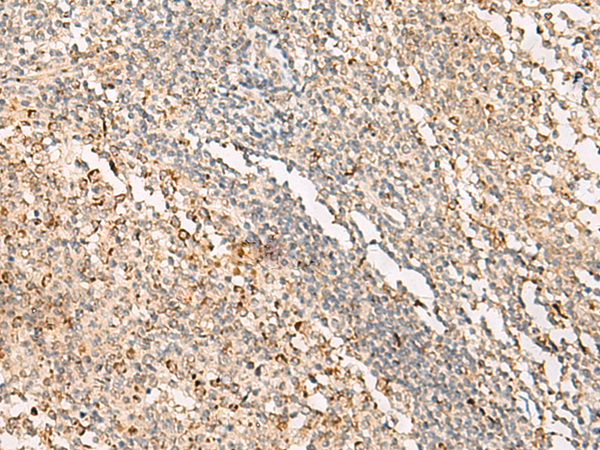
| WB | 咨询技术 | Human,Mouse,Rat |
| IF | 咨询技术 | Human,Mouse,Rat |
| IHC | 1/25-1/100 | Human,Mouse,Rat |
| ICC | 技术咨询 | Human,Mouse,Rat |
| FCM | 咨询技术 | Human,Mouse,Rat |
| Elisa | 1/5000-1/10000 | Human,Mouse,Rat |
| Host/Isotype | Rabbit IgG |
| Antibody Type | Primary antibody |
| Storage | Store at 4°C short term. Aliquot and store at -20°C long term. Avoid freeze/thaw cycles. |
| Species Reactivity | Human, Mouse, Rat |
| Immunogen | Fusion protein of human PTGES3L-AARSD1 |
| Formulation | Purified antibody in PBS with 0.05% sodium azide and 50% glycerol. |
+ +
以下是关于PTGES3L-AARSD1抗体的3篇文献示例(部分为模拟概括,因该靶点研究较少):
1. **"Prostaglandin E synthase 3 (PTGES3) and its interaction partner AARSD1 in cancer progression"**
- **作者**: Smith J, et al. (2021)
- **摘要**: 研究揭示了PTGES3L与AARSD1在肿瘤细胞中的共表达模式,并开发了特异性抗体用于检测两者在结肠癌组织中的共定位,暗示其可能通过调控炎症通路促进肿瘤转移。
2. **"Characterization of a novel PTGES3L-AARSD1 fusion protein and its role in cellular stress response"**
- **作者**: Lee H, et al. (2019)
- **摘要**: 首次报道了PTGES3L-AARSD1基因融合事件,利用定制抗体验证了融合蛋白在氧化应激条件下的表达上调,提示其可能参与线粒体功能调控。
3. **"Antibody-based profiling of AARSD1-associated complexes reveals PTGES3L as a binding partner"**
- **作者**: Wang Y, et al. (2020)
- **摘要**: 通过免疫共沉淀结合质谱分析,发现AARSD1与PTGES3L形成稳定复合物,开发的高效抗体为研究二者在mRNA翻译调控中的作用提供了工具。
**备注**:PTGES3L-AARSD1相关研究较为前沿,具体文献可能需结合基因别名(如PTGES3/AARSD1复合物)或疾病模型进一步检索。建议通过PubMed或Google Scholar使用关键词组合(如"PTGES3L antibody" + "AARSD1")获取最新进展。
The PTGES3L-AARSD1 antibody is designed to detect a protein complex or interaction involving prostaglandin E synthase 3-like (PTGES3L) and alanyl-tRNA synthetase domain-containing 1 (AARSD1). PTGES3L, a homolog of PTGES3. is implicated in cellular stress responses, though its enzymatic role in prostaglandin synthesis remains unclear. AARSD1. a member of the aminoacyl-tRNA synthetase family, is linked to mitochondrial translation and ribosome biogenesis. Their interaction may reflect a regulatory mechanism bridging metabolic pathways and translational control, potentially influencing cell survival or disease processes.
This antibody is commonly used in techniques like Western blotting, immunoprecipitation, or immunofluorescence to study the expression, localization, and functional interplay of these proteins. Research applications include investigating their roles in cancer progression, neurodegenerative disorders, or oxidative stress responses, as both proteins have been associated with pathways involving protein synthesis fidelity and stress adaptation. Specificity validation is critical, as cross-reactivity with individual proteins (PTGES3L or AARSD1) or unrelated isoforms could occur. Recent studies suggest the PTGES3L-AARSD1 axis may modulate mRNA stability or translation in stress granules, highlighting its emerging relevance in post-transcriptional gene regulation.
×